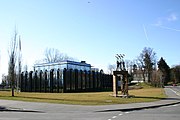Opening

As mandated by the Olympic Charter, various elements frame the opening ceremony of the Olympic Games.Most of these rituals were established at the 1920 Summer Olympics in Antwerp.The ceremony typically starts with the hoisting of the host country's flag and a performance of its national anthem.The host nation then presents artistic displays of music, singing, dance, and theater representative of its culture.The artistic presentations have grown in scale and complexity as successive hosts attempt to provide a ceremony that outlasts its predecessor's in terms of memorability. The opening ceremony of the Beijing Games reportedly cost $100 million, with much of the cost incurred in the artistic segment.
After the artistic portion of the ceremony, the athletes parade into the stadium grouped by nation. Greece is traditionally the first nation to enter in order to honor the origins of the Olympics. Speeches are given, formally opening the Games. Finally, the Olympic torch is brought into the stadium and passed on until it reaches the final torch carrier—often a well-known and successful Olympic athlete from the host nation—who lights the Olympic flame in the stadium's cauldron.
Closing

The closing ceremony of the Olympic Games takes place after all sporting events have concluded. Flag-bearers from each participating country enter the stadium, followed by the athletes who enter together, without any national distinction. Three national flags are hoisted while the corresponding national anthems are played: the flag of Greece, to honor the birthplace of the Olympic Games; the flag of the current host country, and the flag of the country hosting the next Summer or Winter Olympic Games.The president of the organizing committee and the IOC president make their closing speeches, the Games are officially closed, and the Olympic flame is extinguished.In what is known as the Antwerp Ceremony, the mayor of the city that organized the Games transfers a special Olympic flag to the president of the IOC, who then passes it on to the mayor of the city hosting the next Olympic Games.After these compulsory elements, the next host nation briefly introduces itself with artistic displays of dance and theater representative of its culture.
Medal presentation

A medal ceremony is held after each Olympic event is concluded. The winner, second and third-place competitors or teams stand on top of a three-tiered rostrum to be awarded their respective medals.After the medals are given out by an IOC member, the national flags of the three medalists are raised while the national anthem of the gold medalist's country plays.Volunteering citizens of the host country also act as hosts during the medal ceremonies, as they aid the officials who present the medals and act as flag-bearers.For every Olympic event, the respective medal ceremony is held, at most, one day after the event's final. For the men's marathon, the competition is usually held early in the morning on the last day of Olympic competition and its medal ceremony is then held in the evening during the closing ceremony.


